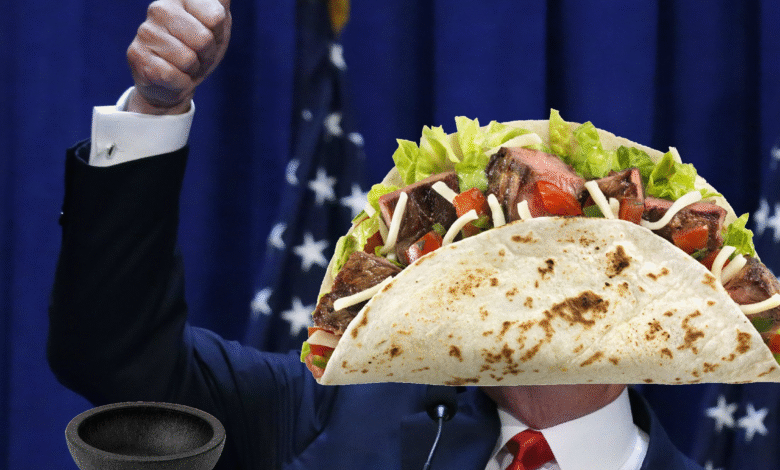Trump TACO Trade: How Tariffs Impact Markets and Negotiations

The term “Trump TACO trade” has emerged as a catchy phrase reflecting President Donald Trump’s controversial tariff policies and their unpredictable impact on markets. The acronym stands for “Trump Always Chickens Out,” highlighting a tendency for Trump to introduce bold tariffs that initially cause market declines, only to later retract or soften them, leading to a market recovery. Critics argue that this inconsistent approach—from the recent 50% EU tariffs to subsequent delays—creates uncertainty in trade negotiations, affecting market confidence and reactions to tariffs. Trump’s negotiation strategy, while claimed to be effective, raises eyebrows among economists who question whether such tactics ultimately benefit the U.S. economy. As discussions surrounding trade intensify, understanding the implications of the Trump TACO trade becomes crucial for investors and policymakers alike.
The phrase ‘Trump TACO trade’ encapsulates a distinctive trend in President Donald Trump’s approach to international tariffs and trade interaction. Focused on an unpredictable pattern of aggressive tariff announcements followed by unexpected retractions, this dynamic has significant implications for financial markets. The acronym ‘TACO,’ alluding to Trump’s perceived retreat from tariff commitments, has sparked debates about the broader impacts on trade relations—especially with the European Union. As the U.S. continues its intricate dance of trade negotiations, the responses from investors and markets reveal much about the underlying sentiment towards such policies. While some view this as a savvy negotiation strategy, others see it as a source of volatility that complicates international trade landscapes.
Understanding the TACO Trade Phenomenon
The concept of ‘TACO trade’—an acronym for “Trump Always Chickens Out”—has emerged as a notable term among market analysts observing the President’s tariff strategies. This term encapsulates a recurring situation where President Trump announces substantial tariffs, leading to immediate market declines, only for him to later soften his approach. Such a pattern has caused investors to question the stability of Trump’s trade policies and their long-term implications on various markets. As he implements tariffs primarily targeting nations such as China and the European Union, the term encapsulates investor skepticism regarding Trump’s capacity to follow through on his threats.
Nonetheless, one cannot disregard the scenario where the mere threat of tariffs can act as a catalyst for negotiations. Trump’s assertions that his actions have paved the way for more robust discussions may hold weight, as economic players often react to tariff announcements with volatility. This often results in short-term dips in the market, followed by rebounds when he announces postponed or reduced tariffs. Such fluctuations reinforce the idea that while the ‘TACO trade’ critiques may highlight uncertainty, they also underscore the negotiation dynamics inherent in global trade.
The Impact of Trump Tariffs on Market Dynamics
Trump’s tariffs, especially against the European Union and other trading partners, present a unique case study on their impact on market behavior. When he announced the imposition of a 50% tariff on EU goods, markets responded predictably; stocks unfortunately plummeted. This reaction illustrates the immediate market apprehension surrounding trade negotiations and tariff policies. Analysts noted that such drastic tariff moves often lead to fears of a trade war, further impacting investor confidence and resulting in turbulent market conditions.
Following the initial backlash, however, there was a noticeable rebound in market performance when Trump indicated a delay on the new tariffs. This contrast illustrates a critical insight into how tariff announcements generate not just immediate fear but also opportunities for negotiations. Investors closely monitor Trump’s negotiation strategy, as it heavily influences market expectations. Such back-and-forth in tariff implementation demonstrates the complex interplay between presidential policies and market dynamics leading to speculation and investment shifts.
Analyzing Trade Negotiations in Light of Tariffs
Trade negotiations under President Trump have become increasingly intricate and often unpredictable. His approach, which integrates aggressive tariffs with tactical pauses, requires analysts to adapt swiftly to evolving landscapes. The negotiations with the European Union symbolize such a balancing act; Trump’s tactic revolves around leveraging tariffs as a means to push the EU towards favorable terms for the U.S. While provocative moves elicit apprehension in the markets, they simultaneously open pathways for discussions that could yield better trade agreements.
The statement made by Trump—”after I did what I did, they said, ‘We’ll meet anytime you want'”—reflects his belief in using tariffs as bargaining chips. In this sense, he reframes the narrative, shifting from a perceived ‘chicken out’ to a realpolitik negotiation strategy. Market reactions can thus become a reflection of broader sentiments around these strategies, capturing both the potential for conflict and the opportunities for collaboration in international trade.
EU Tariffs and Global Trade Stability
The imposition of tariffs on the European Union by President Trump raises critical questions about global trade stability. As the EU represents a significant market for American goods, any tariff increase can lead to retaliatory measures that further complicate trade relations. The tension amplifies concerns about not just immediate market reactions, but the long-term impact on global supply chains and consumer prices. This situation paints a concerning picture for businesses that rely heavily on trade with Europe, as uncertainty can hinder investment decisions.
Furthermore, the reaction from the EU to Trump’s tariffs highlights the intricacy of international trade negotiations. They have expressed intentions to retaliate against U.S. tariffs, revealing a potential trade war that could destabilize markets worldwide. As both sides engage in this high-stakes negotiation, the outcomes will not only affect bilateral relations but will also influence other trading partners globally, making it essential to watch how market responses evolve in light of these tariffs.
The Psychological Impact of Trump’s Tariff Announcements
Trump’s tariff announcements generate significant psychological effects on market participants. Often, immediate responses from investors can be driven more by sentiment and speculation than economic fundamentals. The dramatic fluctuation in prices following Trump’s tariffs demonstrates how closely related market reactions are to his statements. When he announces a tariff, panic or excitement can significantly impact short-term trading behavior, fueled by fear or optimism regarding future trade negotiations.
Yet, this psychological volatility also opens avenues for savvy investors to capitalize on market sentiment. The fluctuations consequent to tariff talk underscore the importance of understanding the underlying psychological factors influencing market behaviors. With Trump’s negotiations leading to delays or rollbacks on promised tariffs, investors can sometimes benefit from the rebound that follows, proving that while psychological impacts may introduce volatility, they can also yield opportunities for profit.
Trump’s Negotiation Strategy and its Market Implications
President Trump’s negotiation strategy appears uniquely intertwined with his tariff policies, revealing a complex approach to international trade relations. His willingness to impose heavy tariffs, followed by quick adjustments or delays, can be seen as an effort to maintain a tough bargaining position. This tactic not only resonates with his base but also communicates a sense of power in negotiations, albeit with notable market consequences. Investors are thus left to weigh the pros and cons of the fluctuating tariffs against the backdrop of potential new trade agreements.
As the markets respond to Trump’s negotiation style, it highlights an important reality: Tariffs can serve as both weapons and negotiating tools in modern trade discussions. As he continues to navigate these negotiations, the ongoing tension between imposing tariffs and rolling them back adds layers of complexity as analysts seek to predict market reactions. Understanding Trump’s methodology could serve investors well, as opportunities may arise from the subsequent adjustments following his often-volatile trade negotiations.
The Interplay Between Tariffs and Domestic Markets
The interplay between Trump’s tariffs and domestic markets invites scrutiny as it reveals deeper implications for consumer behavior and business strategies. Tariffs usually lead to higher costs on imported goods, a direct consequence that often trickles down to consumers through increased prices. Businesses operating in sectors reliant on imports face dilemmas on how best to navigate the rising costs while maintaining competitiveness in the domestic market.
Amidst these challenges, sectors such as manufacturing and agriculture may experience responses that align with Trump’s broader tariffs. For instance, industries directly impacted by tariffs might advocate for current import duties to be lifted, sparking debates on trade policy’s compatibility with economic growth. The dialogue around tariffs forces not only market actors but also policymakers to consider how best to achieve a balance supporting domestic growth while managing international relations.
Updating Strategies in Response to Changing Tariffs
Businesses and investors must continually adapt their strategies in response to the shifting landscape of Trump’s tariffs and trade negotiations. A proactive approach can involve re-evaluating supply chains, anticipating pricing changes, and preparing for increased volatility in market conditions. Analysts frequently advise firms to diversify supply sources and invest in efficiency improvements to mitigate potential tariff impacts. Such strategic adjustments not only shield against immediate market shocks but can also provide competitive advantages in the long run.
As markets react to the ongoing fluctuations in Trump’s tariffs, staying informed about policy changes remains crucial. Investors and business leaders need to develop a keen understanding of how negotiation tactics can influence tariff implementations, allowing companies to pivot accordingly. Embracing agility in business operations effectively sets up firms to weather the storm of unpredictable tariffs while capitalizing on opportunities presented by a shifting trade environment.
The Future of Trade Relations Amidst Trump Tariffs
Looking ahead, the future of trade relations under the shadow of Trump’s tariffs remains uncertain. As countries respond to U.S. tariffs with their tariffs, the possibility of an extended trade war looms larger. This uncertainty poses challenges for businesses planning for investments and expansion in an increasingly interconnected global economy. The shifting dynamics of negotiations, influenced by tariffs, may increasingly dictate diplomatic relations between the U.S. and its trading partners.
Ultimately, as stakeholders in global trade navigate the complexities of these relationships, open dialogues about tariffs can foster a greater understanding of their implications. The winds of change propelled by economic pressures may lead to reforms in trade policies that could redefine the future landscape. Staying abreast of such developments is essential for investors and policymakers alike to adapt to the evolving contours of international commerce.
Frequently Asked Questions
What is the Trump TACO trade and how does it relate to trade negotiations?
The Trump TACO trade, an acronym for ‘Trump Always Chickens Out,’ refers to President Trump’s tendency to announce significant tariffs, causing immediate market reactions, followed by a reduction or delay of those tariffs. This strategy is seen as a method to leverage trade negotiations, particularly with entities like the EU.
How have market reactions been influenced by Trump’s tariffs?
Market reactions to Trump’s tariffs, as illustrated by the TACO trade phenomenon, are often negative initially, causing stock prices to drop. However, when Trump later delays or retracts these tariffs, the markets typically rebound, indicating investors’ volatility in response to trade negotiations.
What role do EU tariffs play in the Trump TACO trade narrative?
EU tariffs are a critical element of the Trump TACO trade narrative, highlighting Trump’s strategy of imposing high tariffs as a bargaining tool in trade negotiations. His announcement of a 50% tariff on EU goods was intended to spark dialogue, although he later deferred it, prompting accusations of ‘chickening out’.
How does Trump justify his negotiation strategy amid criticism of the TACO trade?
Trump defends his negotiation strategy, commonly associated with the TACO trade, by arguing that his aggressive tariff announcements have advanced U.S. interests in trade negotiations. He claims that such tactics are not signs of retreat but rather essential steps towards achieving favorable agreements.
What are the implications of the TACO trade for future trade negotiations with the EU?
The implications of the TACO trade for future trade negotiations with the EU suggest that Trump’s approach may set a precedent for high-stakes bargaining. By utilizing tariffs as negotiation leverage, he aims to achieve more acceptable deals while also managing market perceptions and reactions.
| Key Point | Description |
|---|---|
| Trump’s Tariff Actions | Trump announced significant tariffs, leading to market drops. |
| TACO Trade Definition | TACO stands for ‘Trump Always Chickens Out,’ a term for Trump’s pattern of tariffs and market reactions. |
| Market Reactions | Markets initially drop after announcements, then rebound after delays or reductions. |
| Trump’s Defense | Trump denies backing down, claims his actions lead to better trade negotiations. |
| Impact on EU Negotiations | Trump’s tariffs are intended to invigorate trade discussions with the EU. |
Summary
The Trump TACO trade highlights the complexities of President Trump’s tariff strategies and their impact on market dynamics. Characterized by the acronym ‘Trump Always Chickens Out,’ it reflects the criticism that Trump’s initial tariff announcements cause market instability, which he later tries to mitigate through negotiations. Trump’s defense of his approach suggests that these tariffs are a tactical move aimed at strengthening U.S. trade positions, despite the backlash and the term’s implications. As negotiations with the EU continue, the implications of the TACO trade on market stability remain a critical aspect for traders and investors to monitor.




